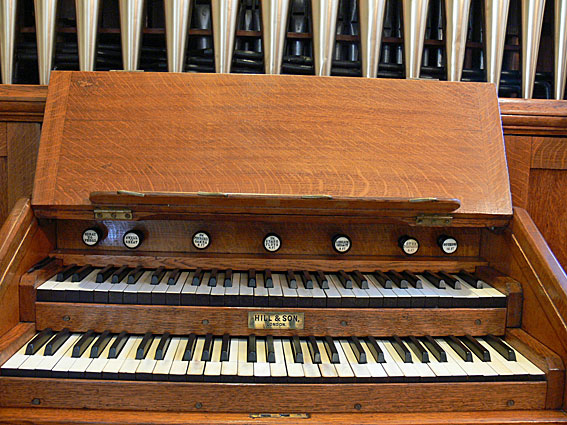
Residence of Dr W. Ralph, Mornington: organ
[photograph by John Maidment (May 2011)]

Residence of Dr W. Ralph, Mornington: organ
[photograph by John Maidment (May 2011)]

Residence of Dr W. Ralph, Mornington: organ
[photograph by John Maidment (May 2011)]

Residence of Dr W. Ralph, Mornington: organ
[photograph by John Maidment (May 2011)]
Historical and Technical Documentation by John Maidment
© OHTA 2011, (last updated May 2018)
This is a small student's practice organ no 9, job number 1372, made in London by Hill & Son in 1871 for R.S. Stacey, of 257 Euston Road, London.1 It would appear that the organ was brought to Victoria around 1889 by Arthur Henry Whinfield (1863-1917), Organist of Christ Church, Brunswick and Director of Music at the Royal Victorian Institute for the Blind who was later managing-director of the English organbuilders Nicholsons of Worcester.2
The organ was first advertised for sale in 18943 (mentioning that it had an oak case) and later in February 1897, the advertisement stating:
PIPE ORGAN (small two-manual) FOR SALE
Seven stops including Pedal Bourdon of 29 notes. A.H. Whinfield, Blind Institute, Prahran.4
Following Whinfield's return to England, the instrument was installed in 1897 at All Saints' Anglican Church, Preston by George Fincham.5 It was replaced at Preston in 1949 by a new organ made by George Fincham & Sons Pty Ltd. It was then installed at the Methodist Church, Murrumbeena. At this time it is understood that the original Hill & Son facade pipes (presumably with rounded mouths) were replaced in zinc with bayleaf mouths. This may have been as a result of damage that took place when the pipes were removed to provide tuning access. The present radiating-concave pedal board constructed from blackwood is not original and clearly replaced a pedalboard with parallel keys, with a compass of 29 notes.
The instrument was purchased in 1976 by Dr William Ralph and was placed in two of his homes in Blackburn, Victoria, before being moved to Queensland in 1989. It was installed in its present location in 2000.

Residence of Dr W. Ralph, Mornington: console
[photograph by John Maidment (May 2011)]

Residence of Dr W. Ralph, Mornington: console
[photograph by John Maidment (May 2011)]

Residence of Dr W. Ralph, Mornington: console sides
[photograph by John Maidment (May 2011)]
The casework , console fittings and bench are of oak, and the Hill & Son brass nameplate, drawstops and engraved labels have been retained. The Pierced Gamba has been replaced with Keraulophon pipes.
The casework has had an upper extension with fretted sections added that matches the style of the Hill casework admirably. This has been designed to be detachable so that the facade pipes can be easily removed for tuning.
| GREAT Open Diapason Lieblich Gedact Swell to Great SWELL Sw Pierced Gamba Sw Suabe Flute PEDAL Bourdon Great to Pedal |
8FT 8FT 8FT 4FT 16FT |
grooved bass grooved bass TC |
Compass: 56/30
Mechanical key and stop action
Lever swell pedal

Residence of Dr W. Ralph, Mornington: drawstop engraving
[photograph by John Maidment (May 2011)]

Residence of Dr W. Ralph, Mornington: oak bench
[photograph by John Maidment (May 2011)]

Residence of Dr W. Ralph, Mornington: lever swell pedal
[photograph by John Maidment (May 2011)]
1 British Organ Archive list of Hill & Son organs by job number (kindly supplied to John Maidment by David Wickens)
2 Personal communication Jim Berrow to John Maidment May 2018
3 The Age, 10 December 1894, p.3
4 Church of England Messenger 1 February 1897, p.15
5 George Fincham letter 10/427 cited in E.N. Matthews, Colonial Organs and Organbuilders (Carlton: Melbourne University Press, 1969), p.145